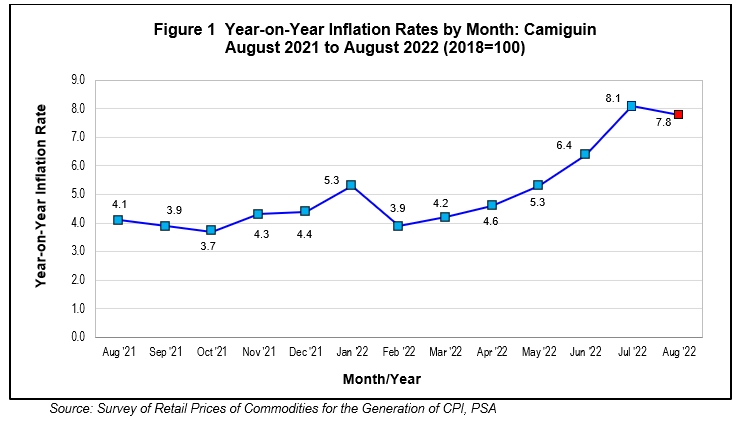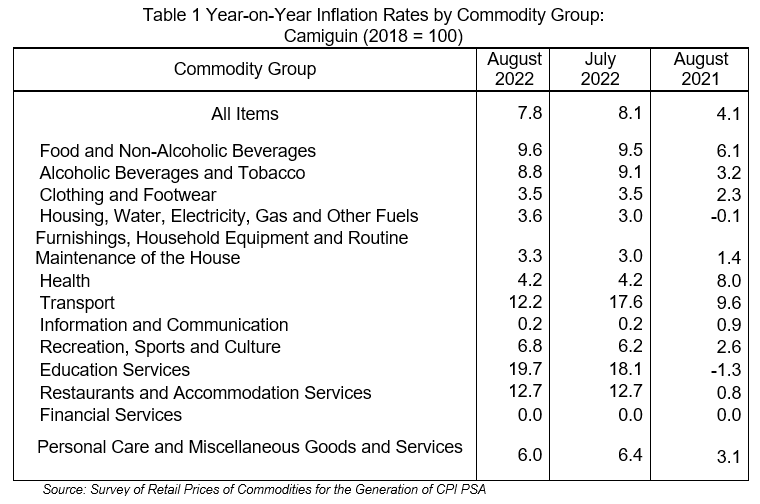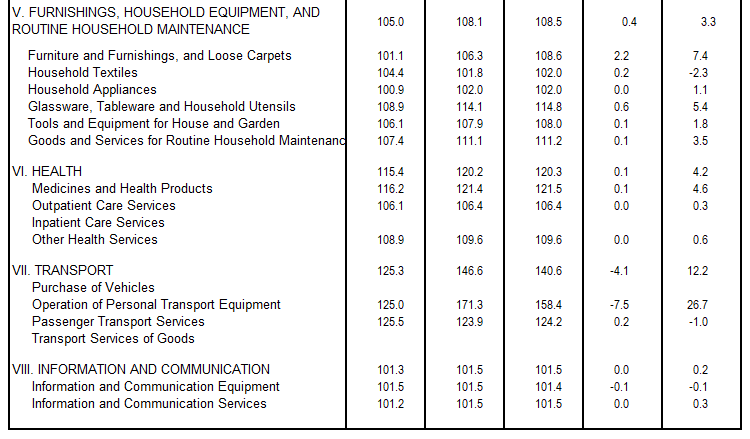Inflation Rate in Camiguin Slowed Down to 7.8%
The annual inflation rate in Camiguin eased to 7.8 percent in August 2022, after recording successive increases for five consecutive months starting March 2022. Bringing the year-to-date inflation rate of the province to 5.7 percent. The recorded rate, however, is 3.7 percentage points higher than the registered rate of 4.1 percent in August 2021. (See Figure 1)

Camiguin still registered the highest annual inflation rate amongst the provinces in the Northern Mindanao region in August 2022. This was followed by Misamis Oriental, with a registered rate of 7.0 percent, greater than the reported rate of 6.0 percent in July 2022 by 1.0 percentage points. Lanao del Norte continued posting the lowest inflation rate in the region for the month of August 2022 at 4.1 percent.
Meanwhile, the region's inflation rate accelerated further to 6.6 percent in August 2022, registering a 0.3 percentage point increase over the rate recorded in July 2022. Inflation at the national level, however, slightly decelerated to 6.3 percent in August 2022, a decrease of 0.1 percentage point from the registered rate of 6.4 percent in July 2022. (See Figure 2)

The slower rate of increase in the overall inflation rate in August 2022 was mainly due to the slightly slower increases posted in the indices of alcoholic beverages and tobacco (8.8%), transport (12.2%), and personal care and miscellaneous goods and services (6.0%). On the other hand, faster rate of increases were posted in the indices of the heavily weighted food and non-alcoholic beverages (9.6%), housing, water, electricity, recreation, sports, and culture (6.8%), furnishings, household equipment and routine maintenance of the house (3.3%), recreation, sports and culture (6.8%), and education services (19.7%). (See Table 1)

Meanwhile, clothing and footwear (3.5%), health (4.2%), information and communication (0.2%), restaurants and accommodation services (12.7%), and financial services (0.0%) indices posted same annual rates in August 2022 with that of July 2022.
Food group indices, on the other hand, continued to rise at 9.9 percent annual rate in August 2022. An increase of 0.2 percentage points than the posted rate of 9.7 percent in July 2022. This increase was primarily due to increments recorded in the indices of cereals (0.4%), rice (0.4%), flour, bread and other bakery products, pasta products and other cereals (6.2%), milk, other dairy products, and eggs (45.3%), oils and fats (10.3%), vegetables, tubers, cooking bananas and pulses (4.3%), sugar, confectionery and desserts (33.1%), ready-made food and other food products not elsewhere classified (6.9%).
Slower rate of increases, however, were registered in the indices of meat and other parts of slaughtered land animals at 7.3 percent, fish and other seafood at 10.6 percent, and fruits and nuts at 19.2 percent in August 2022. (See Table 1a, p. A-1)
(Sgd.) FRANCISCO C. GALAGAR JR.
Chief Statistical Specialist
Technical Notes
This Special Release presents the results of the Survey of Retail Prices of Commodities and Services for the Generation of Consumer Price Index (CPI) conducted in August 2022.
CPI
The CPI is an indicator of the change in the average retail prices of a fixed basket of goods and services commonly purchased by households for their day-to-day consumption relative to a base year.
Uses of the CPI
As an indicator, the CPI is most widely used in the calculation of the inflation rate and purchasing power of the peso. It is a major statistical series used for economic analysis and as monitoring indicator of government economic policy.
The CPI is also used as a deflator to express value series in real terms, which is, measuring the change in actual volume of transactions by removing the effects of price changes. Another major importance of the CPI is its use as basis to adjust wages in labor management contracts as well as pensions and retirement benefits. The CPI also serves as inputs in wage adjustments through the collective bargaining agreements.
Components of the CPI
a. Base Period
This is a reference date or simply a convenient benchmark to which a continuous series of index numbers can be related. Since the CPI measures the average changes in the retail prices of a fixed basket of goods, it is necessary to compare the movement in previous years back to a reference date at which the index is taken as equal to 100.
The present series uses the 2018 as the base year. The year 2018 was chosen as the base year because it is the year when the Family Income and Expenditure Survey (FIES) was conducted. The FIES is the basis of the CPI weights.
b. Market Basket
Market basket refers to a sample of thousands of varieties of goods purchased for consumption and services availed by the households in the country. It was selected to represent the composite price behaviour of all goods and services purchased by the consumers.
c. Weighting System
The weighting system is a desirable system that considers the relevance of the components of the index. For the CPI, the weighting pattern uses the expenditures on various consumer items purchased by households as a proportion to total expenditures.
d. Geographic Coverage
CPI values are computed at the national, regional, and provincial levels, and for selected cities. A separate CPI for NCR is also computed.
e. Classification Standards
The 2012-based CPI series is the first in the series that used the 1999 United Nations Classification of the Individual Consumption According to Purpose (COICOP) in determining the commodity groupings of the items and services included in the market basket. The 2012-based CPI also follows the 2015 Philippine Standard Geographic Classification codes.
Inflation Rate
The inflation rate (IR) is the annual or monthly rate of change of the CPI in percent. It is interpreted in terms of declining purchasing power of money.
Appendix




